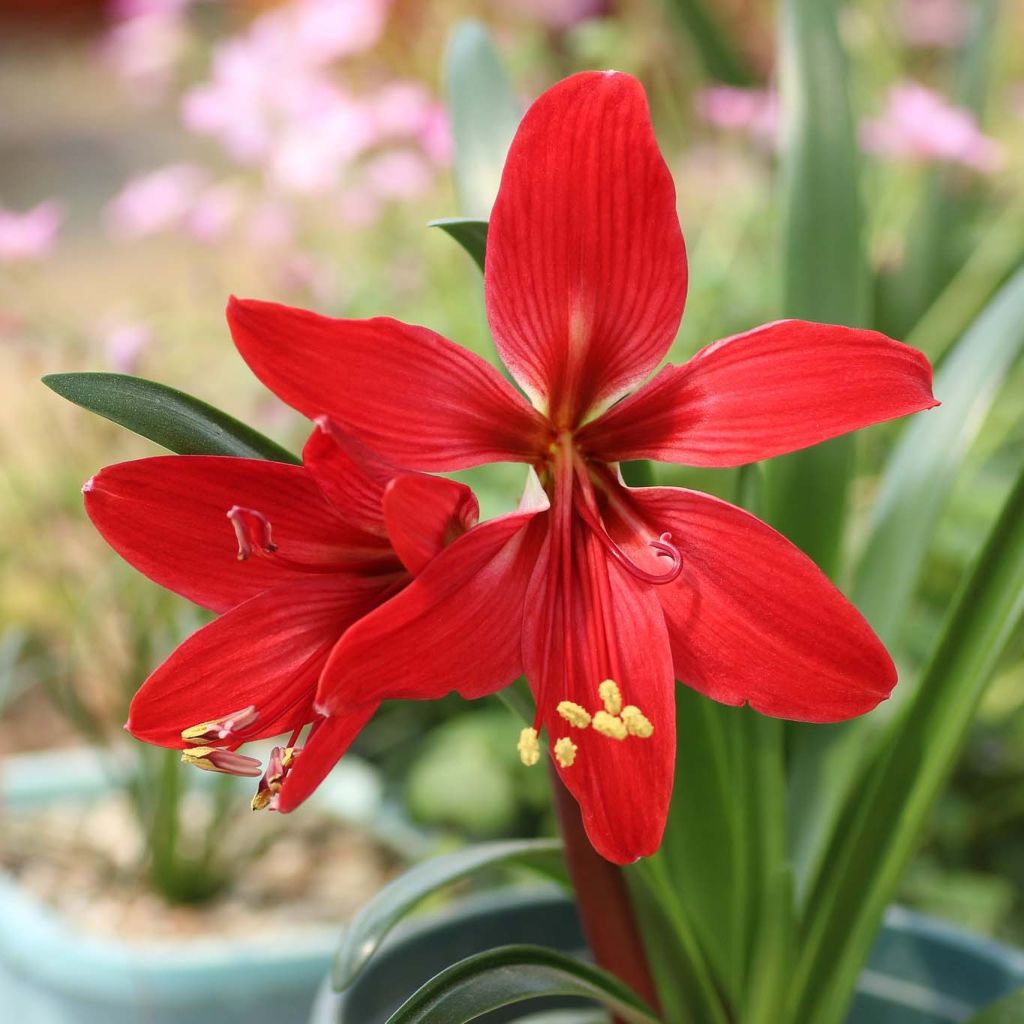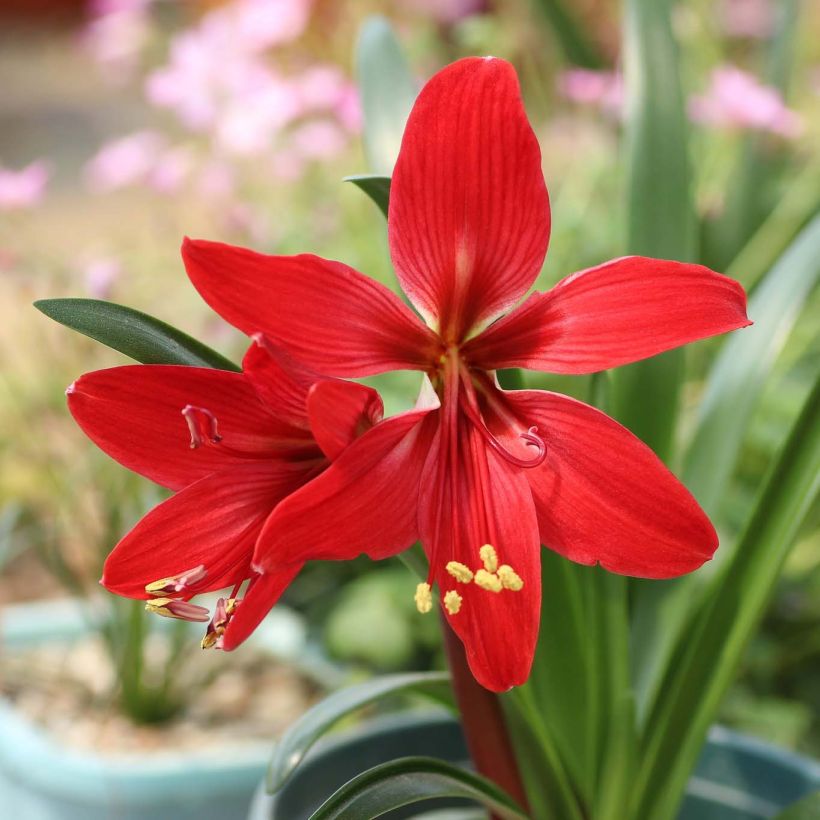

x Hippeastrelia Durga Pradhan - Hybrid Amaryllis
x Hippeastrelia Durga Pradhan - Hybrid Amaryllis
(x) Hippeastrelia Durga Pradhan
Amaryllis orchidée
This plant carries a 6 months recovery warranty
More information
We guarantee the quality of our plants for a full growing cycle, and will replace at our expense any plant that fails to recover under normal climatic and planting conditions.
Does this plant fit my garden?
Set up your Plantfit profile →
Description
Hippeastrelia Durga Pradhan, sometimes called the Amaryllis orchid, is a magnificent bulbous plant resulting from the cross-breeding between a Hippeastrum, the Amaryllis that produces huge trumpet-shaped flowers in winter, and its close relative Sprekelia formosissima, better known as the St. Jacques Lily. This Durga Pradhan hybrid has inherited largeflowers from its first parent, while the second has passed on its magnificent bright crimson colour, finer petals, and a delayed flowering period in late spring. You can grow this marvel in a pot, ideally in a bright conservatory. Space out watering in summer and keep the bulb dry during winter.
Hippeastrelia Durga Pradhan belongs to the Amaryllidaceae family. This hybrid plant was obtained in 1960 by the Indian botanist Udai C. Pradhan. It is a tender, herbaceous perennial plant with a bulb. Growth starts in early spring with foliage, composed of ribbon-like and linear leaves that resemble the Amaryllis and flowering begins in May. From the ground, a cylindrical and robust, purplish red floral stem emerges to about 40 cm (16in) high. At its tip, one to three large lily-shaped flowers appear, measuring over 15 cm (6in) in diameter, with long red stamens protruding. The deciduous foliage turns yellow and dries up a few weeks after flowering. The plant then enters a period of dormancy.
Planting the Hippeastrelia is very rewarding, it is easy to grow, like a Hippeastrum, but with a delayed growth cycle. It grows rapidly and the bulbs multiply quite quickly, forming beautiful clumps within 4 years. Ideally, expose your pot to the sun in front of a window. Cut the stem when the flowers have faded. The plant can remain on the terrace or balcony from May to September.
Report an error about the product description
x Hippeastrelia Durga Pradhan - Hybrid Amaryllis in pictures


Plant habit
Flowering
Foliage
Botanical data
(x) Hippeastrelia
Durga Pradhan
Amaryllidaceae
Amaryllis orchidée
Cultivar or hybrid
Planting and care
You can plant Hippeastrelia Durga Pradhan bulbs in March-April. Choose a pot two to three times larger than the size of the bulb. Place a layer of drainage at the bottom for good drainage. Mix half potting soil, and half garden soil and place the bulb level with the surface of the substrate. Put the pot in a warm and bright place. Water a little until the stem appears. Then water every day and 6 to 8 weeks later, your bulbs will flower. Give them indoor plant fertiliser every 15 days. This is when the bulb replenishes itself to prepare for next year's flowers. Reduce watering after flowering, then stop when the foliage turns yellow. You can then remove the withered leaves and store your potted plant in a cool, dry room to repot the following spring.
Planting period
Intended location
Care
-
, onOrder confirmed
Reply from on Promesse de fleurs
Haven't found what you were looking for?
Hardiness is the lowest winter temperature a plant can endure without suffering serious damage or even dying. However, hardiness is affected by location (a sheltered area, such as a patio), protection (winter cover) and soil type (hardiness is improved by well-drained soil).

Photo Sharing Terms & Conditions
In order to encourage gardeners to interact and share their experiences, Promesse de fleurs offers various media enabling content to be uploaded onto its Site - in particular via the ‘Photo sharing’ module.
The User agrees to refrain from:
- Posting any content that is illegal, prejudicial, insulting, racist, inciteful to hatred, revisionist, contrary to public decency, that infringes on privacy or on the privacy rights of third parties, in particular the publicity rights of persons and goods, intellectual property rights, or the right to privacy.
- Submitting content on behalf of a third party;
- Impersonate the identity of a third party and/or publish any personal information about a third party;
In general, the User undertakes to refrain from any unethical behaviour.
All Content (in particular text, comments, files, images, photos, videos, creative works, etc.), which may be subject to property or intellectual property rights, image or other private rights, shall remain the property of the User, subject to the limited rights granted by the terms of the licence granted by Promesse de fleurs as stated below. Users are at liberty to publish or not to publish such Content on the Site, notably via the ‘Photo Sharing’ facility, and accept that this Content shall be made public and freely accessible, notably on the Internet.
Users further acknowledge, undertake to have ,and guarantee that they hold all necessary rights and permissions to publish such material on the Site, in particular with regard to the legislation in force pertaining to any privacy, property, intellectual property, image, or contractual rights, or rights of any other nature. By publishing such Content on the Site, Users acknowledge accepting full liability as publishers of the Content within the meaning of the law, and grant Promesse de fleurs, free of charge, an inclusive, worldwide licence for the said Content for the entire duration of its publication, including all reproduction, representation, up/downloading, displaying, performing, transmission, and storage rights.
Users also grant permission for their name to be linked to the Content and accept that this link may not always be made available.
By engaging in posting material, Users consent to their Content becoming automatically accessible on the Internet, in particular on other sites and/or blogs and/or web pages of the Promesse de fleurs site, including in particular social pages and the Promesse de fleurs catalogue.
Users may secure the removal of entrusted content free of charge by issuing a simple request via our contact form.
The flowering period indicated on our website applies to countries and regions located in USDA zone 8 (France, the United Kingdom, Ireland, the Netherlands, etc.)
It will vary according to where you live:
- In zones 9 to 10 (Italy, Spain, Greece, etc.), flowering will occur about 2 to 4 weeks earlier.
- In zones 6 to 7 (Germany, Poland, Slovenia, and lower mountainous regions), flowering will be delayed by 2 to 3 weeks.
- In zone 5 (Central Europe, Scandinavia), blooming will be delayed by 3 to 5 weeks.
In temperate climates, pruning of spring-flowering shrubs (forsythia, spireas, etc.) should be done just after flowering.
Pruning of summer-flowering shrubs (Indian Lilac, Perovskia, etc.) can be done in winter or spring.
In cold regions as well as with frost-sensitive plants, avoid pruning too early when severe frosts may still occur.
The planting period indicated on our website applies to countries and regions located in USDA zone 8 (France, United Kingdom, Ireland, Netherlands).
It will vary according to where you live:
- In Mediterranean zones (Marseille, Madrid, Milan, etc.), autumn and winter are the best planting periods.
- In continental zones (Strasbourg, Munich, Vienna, etc.), delay planting by 2 to 3 weeks in spring and bring it forward by 2 to 4 weeks in autumn.
- In mountainous regions (the Alps, Pyrenees, Carpathians, etc.), it is best to plant in late spring (May-June) or late summer (August-September).
The harvesting period indicated on our website applies to countries and regions in USDA zone 8 (France, England, Ireland, the Netherlands).
In colder areas (Scandinavia, Poland, Austria...) fruit and vegetable harvests are likely to be delayed by 3-4 weeks.
In warmer areas (Italy, Spain, Greece, etc.), harvesting will probably take place earlier, depending on weather conditions.
The sowing periods indicated on our website apply to countries and regions within USDA Zone 8 (France, UK, Ireland, Netherlands).
In colder areas (Scandinavia, Poland, Austria...), delay any outdoor sowing by 3-4 weeks, or sow under glass.
In warmer climes (Italy, Spain, Greece, etc.), bring outdoor sowing forward by a few weeks.


































